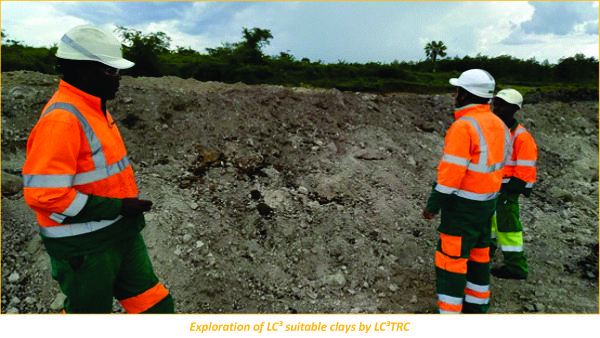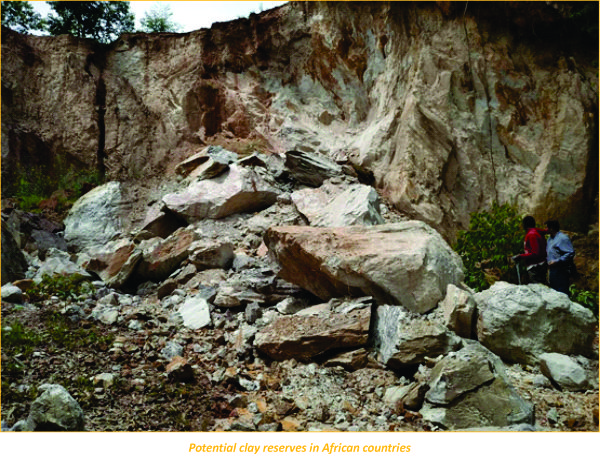Low Carbon Cement Initiatives in Africa
African
countries are booming economies and are in a continuous process of upgrading
their habitat to match the developing world’s standards.This leads to an
exponential rise in the cement market in Africa. TARA, the social enterprise
wing of the Development Alternatives Group has been providing its services
to African cement companies by introducing LC3 a low carbon
cement in their portfolio. As huge clay reserves are present in African
countries, there is great scope for adoption of Limestone Calcined Clay
Cement in Africa.
With a 4.3 billion metric tonne global industry, cement is the second most consumed product, after water1. Cement production is linked with huge emissions of CO2. Globally, this is a serious concern which poses a huge threat to the environment. Therefore, cement companies around the world have started looking for possible alternatives that can reduce their carbon footprint. To address the shortfall, an alternative approach has been developed by EPFL, Switzerland. Limestone Calcined Clay Cement, popularly known as LC3 or simply low carbon cement is an innovative and sustainable cement and has several advantages over the existing commercial cement. LC3 is blended cement that uses limestone and low-grade clay and has low CO2 emissions, low energy input and production cost. A consortium of EPFL, TARA (social enterprise wing of the Development Alternatives Group), CIDEM-Cuba, IIT Delhi and IIT Madras has been continuously pushing their efforts in scaling up and commercialising LC3 in the global cement market. Extensive research by the consortium validates that LC3 can reduce CO2 emissions by upto 40%.
Two special purpose vehicles (LC3
Technology Resource Centre, LC3TRC) have been established in Cuba
and in India. In India, LC3TRC under the aegis of TARA, promotes
LC3 in the global cement market. LC3TRC enables an
ecosystem that facilitates technical handholding through feasibility
services, life cycle assessment, advisory and support, pilot production
advisory services and sale of standard materials. LC3 technology
has created a strong global presence through various initiatives across
different continents.
African countries are booming economies. This is evident through the pace at which infrastructure has been created in the past decade. The projected urbanisation rate in Sub-Saharan Africa is 4.1% which is higher than the global average of 2%.4 The construction sector has grown with a projected growth rate of 6.4% from 2019-2024.5 The major development focus is on the public amenities including hospitals, schools, government establishments, ports, highways, bridges etc. This leads to an exponential rise in the cement market in Africa and opens fresh avenues for TARA to intervene in the sector. LC3TRC provides its services to African cement companies by introducing LC3 cement in their portfolio. The exploration in many of African countries is in the nascent stage. As huge clay reserves are present in African countries, there is great scope of development. The proper investigation and feasibility studies will explore potential clay reserves suitable for LC3 application. LC3TRC acts as a catalyst to mainstream LC3 adoption. Few such examples in Africa are in Uganda, Rwanda and Senegal where LC3TRC has explored potential clays for LC3.
LC3 introduction in the cement plants and market will pave the way for a more sustainable and green environment. On one hand, it will boost infrastructure development and on the other hand, it will support the environment. With the utilisation of waste clay in LC3 production, the load and dependency of cement companies on virgin resources will reduce. Through this way, mineral resources can be secured and in this effort, LC3TRC is in a continuous action to support the developing economies in different geographies. ■
References:
-
Limestone calcined clay cement as a low-carbon solution to meet expanding cement demand in emerging economies. Yudiesky Cancio Díaza, Sofia Sánchez Berriel, Urs Heierli, Aurélie R. Favier, Inocencio R. Sánchez Machado, Karen L. Scrivener, José Fernando Martirena Hernández, Guillaume Habert. Development Engineering 2 (2017) 82–91
-
https://www.greenbiz.com/article/concrete-change-making-cement-carbon-negative
-
https://www.khl.com/news/boost-for-global-cement-demand-/69957.article
-
https://www.csis.org/analysis/urbanization-sub-saharan-africa
Dr. Ankur Sarswat
asarswat@devalt.org